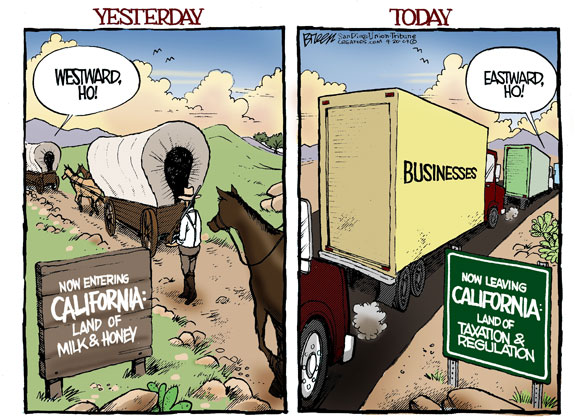 Move to low-tax state of Tennessee a real eye opener
Move to low-tax state of Tennessee a real eye opener
by Arthur Laffer
In June of 2006, I deserted my long-time friend and love of my life, California, for the unknown venue of Tennessee. The push and the pull of the two locations are pretty obvious — taxes. Tennessee, like Texas, has no state income tax, no state capital gains tax, lower property taxes, lower workers’ compensation costs and roughly the same sales tax rate. California, on the other hand, is just simply tax- and fee-crazy.
But in spite of all the tax, fee and regulatory reasons for leaving California, I was deeply concerned that I would be stranded in an uneducated, lawless morass of tobacco-chewing Neanderthals driving old clunkers on dirt roads where churches were on every street corner and there wasn’t a hospital to be found.
To me the choice seemed to be between higher after-tax income versus a civilized society with a higher quality of life.
Little did I know.
California does have the sunshine, that’s true, but to believe all your taxes are giving you a better quality of life and better public services is not true. And, I never believed claims that government was responsible for the sunshine, either.
Take public education, for example. California employs 231 full-time equivalent educators per 10,000 population while the U.S. average is 286 per 10,000 people and Texas, with even less taxes than Tennessee, employs 345 educators per 10,000 population.
According to U.S. Department of Education test scores of children in grades K through 12, California’s students rank fourth from the bottom of the 50 states. And this latest ranking is California’s best in a number of years. Compared to the four other megastates — New York, Illinois, Florida and Texas — California is dead last, and by a long shot.
California’s educators, however, are paid way more than other states’ educators and are more highly unionized as well. Over the last decade, for example, California teachers went on strike 170 times while in Texas teachers are prohibited from striking. And to put in the final nail, the California teachers union is the largest single contributor to political campaigns in California over the past decade — double that of the next largest contributor. Go figure!
California highway personnel are paid more than $10,000 per year more than any other state’s highway employees and still California’s highways are ranked dead last of all 50 states by the Reason Foundation. To build one mile of standardized highway in California costs $265,000 while for that same mile of highway in Texas the average cost is a little over $88,000. Then again, anyone who commutes by car in California knows highway problems better than any so-called expert.
California’s problems with prison guards, prison population and prison facilities are legend. California has 33 percent fewer prisoners per 100,000 population than does Texas. But even with so many fewer prisoners, California earlier this year had prisons operating at 175 percent of design capacity while Texas prisons were operating at 15 percent below design capacity. And now, after a U.S. Supreme Court ruling, California will have to release enough prisoners to get the prison population down to only 37.5 percent above design capacity. Oh, just for completeness, California’s corrections employees are the second-highest-paid corrections employees in the U.S.
The same story — overpaid public servants and fewer of them — holds for fire protection employees and hospital employees. On a state and local level, California’s hospital and fire protection employees are the highest-paid in the nation bar none and the number of them per 10,000 population is well below the national average.
I could go on and on, but let me just add one confession.
When it comes to both the number of public welfare employees per 10,000 population and their pay, California is way above the national average. But then again, with one of the nation’s highest poverty rates — 13 percent above the national average in 2011 — it only stands to reason.
I still miss and love the California I once knew. And maybe a little advice from New York City’s Mayor Michael Bloomberg could help:
The more a city spends on wages and benefits for employees over what the marketplace determines is necessary for recruitment, retention and experience, the less a city can invest in benefits for all residents. The less it invests in things that benefit all residents, the less attractive a place it is to live and visit.
And suddenly, the virtuous cycle I mentioned at the beginning of this essay comes grinding to a halt — or worse, goes spinning in reverse.
. . . . . . . . . . . . . . .
Laffer, a former San Diego County resident, is an economist and consultant. This article was published in the San Diego Union-Times.